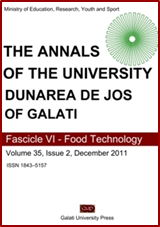Improved solubilization of curcumin with a microemulsification formulation
Abstract
Due to the large number of bioactive substances, with low and very low solubility in water, new and improved investigation methods were developed. Researches in this area have shown that lipid systems in lipophilic substances formulation increase their bioavailability and prevent or reduce the toxicological risk because most of the components involved in the formulation are of natural origin, with a structure compatible with biological membranes components. Among the lipid systems used in the leaching, transport and release of lipophilic substances there are: liposomes, solid lipid nanoparticles, double and single emulsions, autoemulsionante and auto-microemulsionante lipid systems. The last are the subject of the present research and meet specialists in concern for the harmonization of cost-benefit-risk in order to improve population health. Curcumin [(1E, 6E)-1,7-bis(4-hydroxy-3-methoxyphenyl)-1,6-heptadiene-3,5- dione] is a yellow pigment derived from the rhizome of the plant Curcuma Longa with phenol groups and conjugated double bounds which is unstable at light and basic pH, degrading within 30 minutes. The aim of this study is curcumin solubilization used as alimentary dye in automicroemulsionante systems. Dye/oil/surfactant/cosurfactant mixing ratio was made, based on quaternary phase diagrams. Mesofazice structures were revealed by conductivity and viscosimetric analysis. A curcumin solubilization system in aqueous medium was obtained. On the other hand, this paper studies the colour evolution of these automicroemulsionante systems comparing with hexane dye solution. The use of the chromatic attributes L*, a* and b* and L*, C* and hab,
suggested by the Commission Internationale de l’Eclairage (CIE) (i.e., the CIELAB system), obtained from direct transmitance measurements, which made it possible to follow the evolution of colour.


